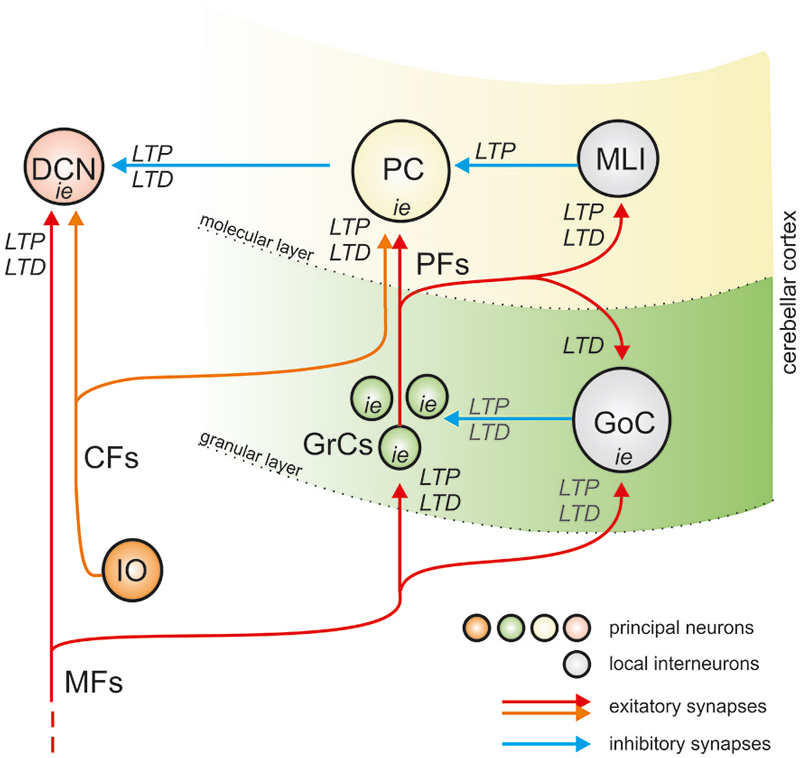Answer: Long term depression is a reduction in synaptic efficiency that persists for hours or longer.
Recall that long term potentiation is the strengthening of synapses in response to repeated stimulation. LTP is an important process which models learning in the hippocampus. Alternatively, long term depression (LTD) is the weakening of synapses which accompanies little or no stimulation; LTD can be thought of as the inverse of LTP and plays an equally important role in establishing biological mechanisms for learning and memory. However, much less in known about the precise biological mechanisms of LTD.
Long term depression is not to be confused with major depressive disorder (MDD). LTD is a cellular mechanism which examines the nervous system at the level of synapses and cells. MDD is a clinical diagnosis that is made during a psychological assessment of a person using criteria set forth by the DSM-V and may be measured using one of several psychological tests, like the Beck depression index.
Though gaps in information do exist, there is a lot of information that has been discovered regarding LTD. LTD is generally discussed in two areas: the hippocampus and the cerebellum.
LTD in the cerebellum
LTD in the cerebellum is slightly more complex than its hippocampal counterpart. To understand the process entirely, we must first discuss the anatomy of the cerebellar cortex. The cerebellum receives input from the motor cortex and the spinal cord, and the cortex consists of three cellular layers: the granule layer, the Purkinje layer, and the molecular later. Granule cells lie in the granule layer, and their axons ascend into the molecular layer where they split and form parallel fibers. Purkinje cells reside in the middle layer, the Purkinje layer, and their dendrites form extremely complex structures seen in the molecular layer in image 1 above. The dendrites of the Purkinje cells line up with the parallel fibers and form synapses in the molecular layer.
There are two main forms of input to the cerebellum: climbing fibers and mossy fibers. Climbing fibers originate in the medulla, specifically, the inferior olive and travel to the Purkinje cell where the climbing fiber twists itself around the Purkinje cell dendrite and forms synapses. Action potentials from the climbing fibers generate EPSPs which activate the Purkinje cells.
The second input, mossy fibers, arise from the brain stem and synapse on granule cells. These granule cells, whose axons are parallel fibers ascending into the molecular layer where they encounter the Purkinje cell. Thus, there is a point where the parallel fibers and climbing fibers can simultaneously provide input to the Purkinje cells. This is the essential point for LTD.
Simultaneous activation of these pathways results in synaptic modifications of the Purkinje fiber. Climbing fiber activation depolarizes the Purkinje cell, and this activates calcium channels resulting in a calcium influx into the cell. On the other hand, parallel fiber activation has two outcomes. By releasing glutamate upon activation it can activate AMPA receptors on the Purkinje cells membrane, which results in a sodium influx into the Purkinje cell. The same glutamate release also stimulates metabotropic glutamate receptors, which activate phospholipase C. The activation of phospholipase C leads to the production of diacylglycerol which activates protein kinase C. Protein kinase C and calcium work together to decrease postsynaptic response of AMPA, which demonstrates the plasticity that is associated with LTD. This decrease in response results in the synaptic inefficiency that is characterized by LTD.
LTD in the hippocampus
As previously mentioned, long term depression is commonly discussed in two brain structures parts, the second being the hippocampus. The mechanisms of LTD here are less well understood and still under investigation. The lack of stimulation that occurs results in a weak depolarization of the postsynaptic neuron. In LTP, depolarization of the postsynaptic neuron results in a displacement of the magnesium block; however, in LTD, activation is not strong enough to displace the block and results in a small amount of calcium flowing into the cell. This calcium activates phosphatases which dephosphorylate proteins. LTD is associated with dephosphorylation and internalization of AMPA receptors, which leads to a decrease in synaptic efficiency similar to what is seen in the cerebellum.
The concept of LTD is extremely important, as it demonstrates a molecular model for synaptic plasticity - one of the most important capabilities of the brain. LTD is an essential concept for understanding the biological mechanisms of learning and memory. Though many of these mechanisms are still unclear and incomplete, ongoing research will likely provide more knowledge into specific aspects of this process.
